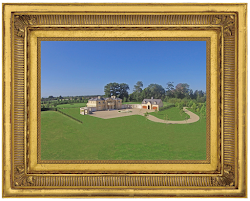Friday, August 31, 2012
Don't fence me in...
Another recent mission on the farm was to re-fence all 7 paddocks with post and rail fencing. The 5 wire electric fence was OK for keeping the horses in, but the goats and the sheep with their insulating coats would run under the bottom wire without a care, which was making pasture management difficult.
So, 150 posts and 2.5 km of timber later, we now have posh 3 rail fences with hot wires above and below and in between the rails. We did it ourselves with the help of a neighbour. Since then we have not had any problems with our obstinate ruminants!
Above: The old fencing.
Below: The new fencing. Note the late Winter rainfall.
We also built a 5m x 5m box in the middle of each fence, and have planted a stand of oak trees in each box. In time it will be a picturesque way to provide shade for the animals in the Summer months...
The new fencing will also mean that we will be all set up to keep a Highland bull next year without him wandering. Our girls are coping well with the wet weather...
Monday, August 27, 2012
Chestnuts and Marron Glace...
The sweet chestnut, Castanea sativa, is a member of the fagaceae family (Oaks and Beeches), and is a native of Europe.
It has a very prickly seed pod, containing 4 chestnuts, each in its own hard brown husk. The secret to picking good chestnuts is get them as soon as they drop on the ground and open up. They won't be ready until they have dropped, and will go off if they have been on the ground too long.
The nuts can be roasted, used for stuffing, puréed into paste for use in chocolate cakes and various baked goods, or they can be candied, into the traditional French Christmas delicacy - Marron Glacé.
Ingredients:
2 pounds chestnuts, shelled
2 pounds granulated sugar
2 1/2 cups water
1 teaspoon vanilla extract
Preparation:
Place the chestnuts in a large pan with just enough water to
cover them. Bring the water to a boil and cook the chestnuts for 10 minutes.
Drain and discard the water. Rub the
husk off the cooked chestnuts.
In a separate pan, bring the 2 1/2 cups water, granulated
sugar, and the vanilla to a boil, stirring constantly. Simmer, stirring
occasionally, for 5 minutes.
Add the chestnuts to the boiling syrup and stir until the
whole mixture returns to a boil. Continue cooking, stirring frequently, for 10
minutes. Pour the candied chestnuts, along with the vanilla sugar syrup into a
large container, and cover. Allow the chestnuts to soak in the syrup for 12
hours.
Add the chestnuts and syrup to a clean pan and repeat the
process; this time boiling for 2 minutes, and then allowing to soak for 24
hours. Repeat this process 3 to 4 times, until the sugar syrup has been
absorbed completely by the chestnuts.
Preheat an oven to 120C (250F) and arrange the candied
chestnuts on a sheet of baking paper. Place the chestnuts into the oven and
turn off the heat. Allow the chestnuts to dry in the oven for 45 minutes to 1
hour, until they are dry to the touch.
Wrap in grease proof bon bon paper, or powder lightly with
confectioner’s sugar and place in a jar.
At Willowbrook we have finally finished planting The Nuttery and Bois de Marie.
In The Nuttery we have 12 Hazelnut trees, 10 Chestnuts, 9 Almonds, and 3 Walnuts. We finished planting The Nuttery a little while ago when we had friends down for the weekend, and their children Lucas and Elsa planted their own Chestnut trees...
They finished off their visit with a trip to the farm to pet the animals...
Labels:
Bois de Marie,
Chestnut,
Marron Glace,
Nuttery,
Recipe
Thursday, August 23, 2012
Boys Camping Trip
After a pretty hectic few weeks, a mate and I decided we should go on a boys' fishing trip.
I drove down to a small rural hospital on Tuesday and did a locum shift there, and then my friend met me there in the evening and we set off to commune with nature. We headed off to a small spot on the banks of the Whanganui river, about 30 minutes out of Taumaranui, which the local fishing store owner had recommended.
We found a good spot near the river to pitch our tents. I had borrowed a tent from a camping friend, which did not come with instructions and didn't at all resemble the traditional tent shape that I was used to as a boy scout. Erecting it was like the Krypton factor, but after wrestling with it in the dark for half an hour it resembled something inhabitable...
After getting our bearings we hunkered down for a slap up meal on the camp fire and a bottle of scotch. The evening passed quickly and soon we hit the hay. I slept well, but my friend awoke during the night to find that our camp was being rummaged through by some marauding wild goats!
Above: We later found the pack of wild goats across the river, half way up a hill...
It was a cold night, getting down to a couple of degrees below zero, but the tents were surprisingly warm, which made outside rather bracing for breakfast.
Above: The early morning fog over the valley
Below: Getting up in the morning
Below: One of the many frosty-morning cobwebs..
We then set off for an early start fishing. It soon fined up into a lovely day for it...
Above: Wading out into the middle of the river
Below: The view up the river from the middle
I tried several flies: assorted nymphs, various variations on a Wooly Bugger, and some glow bugs...
Alas, we didn't get so much as a bite. So by lunch we headed back to camp and scoffed some bacon butties for lunch (I'm not much of a Bear Grylls when it comes to food, so it was lucky we packed a little F&M styled hamper for the eventuality that we didn't catch anything.
Unfortunately it is illegal to sell or buy trout in New Zealand, so the only way to taste one is to catch it yourself.
In the afternoon we packed up camp and headed down to National Park to another supposedly good fishing spot there, but again no luck. We packed up and came home empty handed, but it was good to get away from it all for a day or two.
Labels:
Camping,
Countryside,
Fishing,
hunting,
Whanganui River
Tuesday, August 14, 2012
Morning Moon Over Farm
Yesterday I got up early to check on the stock and let the goats out of their shelter. It was about 6 am, and still pitch black, but there was a lovely moon...
It has been tipping down lately, and I can't wait til Spring arrives, and with it daylight savings time. It's horrid getting up and going to work in the dark then coming home, again in the dark. And to top it all off I've been down with a horrid chest infection. Never mind, soon We should be up and on top of things again with some new posts and some more pics of the landscaping progress.
Labels:
Moon,
Willowbrook Park,
Winter
Friday, August 10, 2012
Taking the bull by the horns...
I wanted to surprise Peter for his birthday with something unique. I decided to make him a pair of book ends using Bella's horns. I got several pieces of pine mouldings and glued them together, then cut them to length and stained and varnished them. I then cleaned and sanded the horns and varnished them before mounting them on the wooden mouldings...
Labels:
Edward and Bella,
horn,
Peter Lord Cowell,
Study,
Taxidermy
Tuesday, August 7, 2012
Pig Hilton Mark 2...
After 2 years of breeding Wessex Saddlebacks, we were in need of a larger pig sty. Pig 'Hilton' mark one was a rectangular ark made of plywood, open at one end - functional but not pretty. I did some research into traditional pig stys, ones that would look at home on an English-styled farm. There were several which caught my attention...
Above: A Traditional Welsh Pig Sty
I like the look of the old traditional pig stys, but they are impractical, non-transportable, and designed for non free-range pigs.
Having seen some of the shelters on the market...
And some old stone huts...
...I struck upon the idea of making a stone-look sty out of wood. So, my grandfather and I set about building Pig Hilton mark 2 - out of completely recycled materials.
We had some timber from previous projects lying around, and we pulled the plywood lining off the inside of the current barn (knowing that it is going to be demolished to make way for the driveway next year). One of our neighbours gave us a whole lot of spare roofing iron, and so we were set to start building.
Above: Old Timber which we used to create the floor (below)
The floor size was 7'x10'.
Above: Putting the framing for the walls up
Below: Starting to make the trusses for the roof
The finished roof framing
Below: Cutting the roofing iron
Putting on the roof...
All the way through my grandfather taught me heaps of helpful hints and tips that I will be able to apply to any other buildings in the future.
Almost completed project - structurally finished with gate latched back against wall. Now we just need to find some stone coloured paint and set about adding the finishing touches.
Below: The old pig sty, with the brook swollen with water due to all the rain we have had.
I'll post an update once we've painted it. Now I've learnt how to build a gabled animal shelter, my next project is going to be a potting shed for the middle of the potager garden.
Subscribe to:
Posts (Atom)















































































































